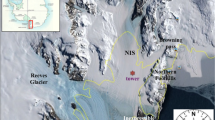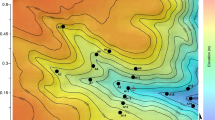Abstract
Large sudden wind-direction shifts and submeso variability under nocturnal conditions are examined using a micrometeorological network of stations in north-western Victoria, Australia. The network was located in an area with mostly homogeneous and flat terrain. We have investigated the main characteristics of the horizontal propagation of events causing the wind-direction shift and not addressed in previous studies. The submeso motions at the study site exhibit behaviour typical of flat terrain, such as the lower relative mesovelocity scale and smaller cross-wind variances than that for complex terrain. The distribution of wind-direction shifts shows that there is a small but persistent preference for counter-clockwise rotation, occurring for 55% of the time. Large wind-direction shifts tend to be associated with a sharp decrease in air temperature (74% of the time), which is associated with rising motion of cold air, followed by an increase in turbulent mixing. The horizontal propagation of events was analyzed using the cross-correlation function method. There is no preferred mean wind direction associated with the events nor is there any relationship between the mean wind and propagation directions. The latter indicates that the events are most likely not local flow perturbations advected by the mean flow but are rather features of generally unknown origin. This needs to be taken into account when developing parametrizations of the stable boundary layer in numerical models.











Similar content being viewed by others
References
Acevedo OC, Costa FD, Oliveira PES, Puhales FS, Ga Degrazia, Roberti DR (2014) The influence of submeso processes on stable boundary layer similarity relationships. J Atmos Sci 71(1):207–225
Anfossi D, Oettl D, Degrazia G, Goulart lA (2005) An analysis of sonic anemometer observations in low wind speed conditions. Boundary-Layer Meteorol 114(1):179–203
Belušić D, Güttler I (2010) Can mesoscale models reproduce meandering motions? Q J R Meteorol Soc 136(648):553–565
Belušić D, Mahrt L (2008) Estimation of length scales from mesoscale networks. Tellus A 60(4):706–715
Belušić D, Mahrt L (2012) Is geometry more universal than physics in atmospheric boundary layer flow? J Geophys Res Atmos 117:d09115. doi:10.1029/2011JD016987
Cava D, Mortarini L, Giostra U, Richiardone R, Anfossi D (2016) A wavelet analysis of low-wind-speed submeso motions in a nocturnal boundary layer. Q J R Meteorol Soc. doi:10.1002/qj.2954
Grachev AA, Fairall CW, Persson POG, Andreas EL, Guest PS (2005) Stable boundary-layer scaling regimes: the SHEBA data. Boundary-Layer Meteorol 116(2):201–235
Güttler I, Belušić D (2012) The nature of small-scale non-turbulent variability in a mesoscale model. Atmos Sci Lett 13(3):169–173
Hande L, Siems S, Manton M, Belusic D (2012) Observations of wind shear over the southern ocean. J Geophys Res Atmos 117:d12206. doi:10.1029/2012JD017488
Kang Y, Belušić D, Smith-Miles K (2015) Classes of structures in the stable atmospheric boundary layer. Q J R Meteorol Soc 141:2057–2069. doi:10.1002/qj.2501
Mahrt L (2007) Weak-wind mesoscale meandering in the nocturnal boundary layer. Environ Fluid Mech 7(4):331–347
Mahrt L (2008) Mesoscale wind direction shifts in the stable boundary-layer. Tellus A 60(4):700–705
Mahrt L (2010) Common microfronts and other solitary events in the nocturnal boundary layer. Q J R Meteorol Soc 136(652):1712–1722
Mahrt L (2014) Stably stratified atmospheric boundary layers. Annu Rev Fluid Mech 46:23–45
Monserrat S, Thorpe AJ (1992) Gravity-wave observations using an array of microbarographs in the Alearic Islands. Q J R Meteorol Soc 118(504):259–282
Monti P, Fernando HJS, Princevac M, Chan WC, Kowalewski TA, Pardyjak ER (2002) Observations of flow and turbulence in the nocturnal boundary layer over a slope. J Atmos Sci 59(17):2513–2534
Mortarini L, Stefanello M, Degrazia G, Roberti D, Castelli ST, Anfossi D (2016) Characterization of wind meandering in low-wind-speed conditions. Boundary-Layer Meteorol. doi:10.1007/s10546-016-0165-6
Poulos GS, Blumen W, Fritts DC, Lundquist JK, Sun J, Burns SP, Nappo C, Banta R, Newsom R, Cuxart J et al (2002) CASES-99: a comprehensive investigation of the stable nocturnal boundary layer. Bull Am Meteorol Soc 83(4):555–581
Rees JM, Mobbs SD (1988) Studies of internal gravity waves at Halley Base, Antarctica, using wind observations. Q J R Meteorol Soc 114(482):939–966
Sandu I, Beljaars A, Bechtold P, Mauritsen T, Balsamo G (2013) Why is it so difficult to represent stably stratified conditions in numerical weather prediction (NWP) models? J Adv Model Earth Syst 5(2):117–133
Suarez A, Stauffer DR, Gaudet BJ (2015) Wavelet-based methodology for the verification of stochastic submeso and meso-gamma fluctuations. Mon Weather Rev 143(10):4220–4235
Sun J, Lenschow DH, Mahrt L, Nappo C (2013) The relationships among wind, horizontal pressure gradient, and turbulent momentum transport during CASES-99. J Atmos Sci 70(11):3397–3414
Sun J, Mahrt L, Nappo C, Lenschow DH (2015a) Wind and temperature oscillations generated by wave-turbulence interactions in the stably stratified boundary layer. J Atmos Sci 72(4):1484–1503
Sun J, Nappo CJ, Mahrt L, Belušić D, Grisogono B, Stauffer DR, Pulido M, Staquet C, Jiang Q, Pouquet A et al (2015b) Review of wave-turbulence interactions in the stable atmospheric boundary layer. Rev Geophys 53(3):956–993
Vercauteren N, Klein R (2015) A clustering method to characterize intermittent bursts of turbulence and interaction with submesomotions in the stable boundary layer. J Atmos Sci 72(4):1504–1517
Vercauteren N, Mahrt L, Klein R (2016) Investigation of interactions between scales of motion in the stable boundary layer. Q J R Meteorol Soc. doi:10.1002/qj.2835
Vickers D, Mahrt L (2007) Observations of the cross-wind velocity variance in the stable boundary layer. Environ Fluid Mech 7(1):55–71
Vickers D, Mahrt L, Belušić D (2008) Particle simulations of dispersion using observed meandering and turbulence. Acta Geophys 56(1):234–256
Wilczak JM, Oncley SP, Stage SA (2001) Sonic anemometer tilt correction algorithms. Boundary-Layer Meteorol 99(1):127–150
Acknowledgements
We are grateful to four anonymous reviewers for useful and constructive comments that helped to improve the manuscript.
Author information
Authors and Affiliations
Corresponding author
Rights and permissions
About this article
Cite this article
Lang, F., Belušić, D. & Siems, S. Observations of Wind-Direction Variability in the Nocturnal Boundary Layer. Boundary-Layer Meteorol 166, 51–68 (2018). https://doi.org/10.1007/s10546-017-0296-4
Received:
Accepted:
Published:
Issue Date:
DOI: https://doi.org/10.1007/s10546-017-0296-4




